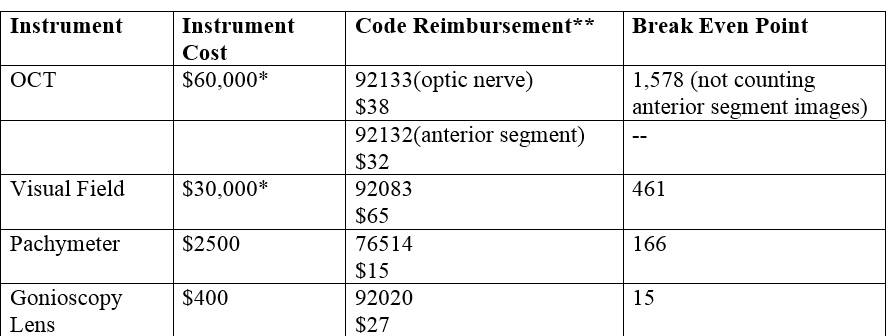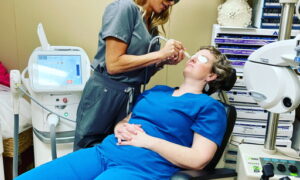By Daniel Epshtein, OD FAAO

April 25, 2018
An aging population in the U.S., and the increasing availability of health insurance, is set to increase patient visits drastically.
Glaucoma is one disease which optometrists are well positioned to manage, and should welcome as a backbone of their practices. With this sight-threatening disease affecting a greater percentage of your patients, ensuring that you are well prepared to handle this influx of patients can become an essential practice-builder.
With great advancements in diagnostic equipment and medications, most glaucoma patients will only require medical therapy or minor surgical procedures. Most often only those patients who need treatment for narrow-angle glaucoma, or who have advanced disease requiring surgical intervention, will need to be referred out.
 I currently practice at Mount Sinai St. Luke’s, and a private practice, in New York City. I previously worked at a high-volume, multi-specialty practice where I provided refractive, medical and perioperative care.
I currently practice at Mount Sinai St. Luke’s, and a private practice, in New York City. I previously worked at a high-volume, multi-specialty practice where I provided refractive, medical and perioperative care.
In my previous practice, where I was seeing 30-35 patients a day (many of whom had glaucoma), I would refer one patient every two months to a glaucoma specialist. The rest of the patients I was able to manage myself, or by sending for LPI, SLT, cataract surgery, or minimally invasive glaucoma surgery (MIGS) to our general/cataract ophthalmologist.
With the popularity of MIGS, many patients can achieve adequate IOP control without traditional glaucoma surgery. MIGS are often performed at the time of cataract surgery by an increasing number of cataract surgeons, and most procedures have a great risk profile. The OD can co-manage these patients after the surgical procedure by setting up a co-management relationship with the surgeon. Once the surgical global period is completed, standard glaucoma care can be continued.
Glaucoma Niche Especially Profitable for Senior-Heavy Practices
Practices with a large senior population have the greatest reason to turn glaucoma care into a niche due to the increased incidence of glaucoma with increasing age. Older patients are also more likely to return for their follow-up appointments because they understand the need for early intervention. In contrast, many young patients will often not return for follow-up care, especially for asymptomatic diseases such as glaucoma.
Due to the lack of symptoms in its early stages, glaucoma is a difficult condition to promote adherence to treatment and follow-up. In these patients, education is key. I have had the best results by reviewing auxiliary testing such as OCTs and visual fields with the patient. This way, they understand what we are looking for and why it is necessary to periodically repeat these tests. I believe that younger patients especially appreciate this approach because they often read online about the various ways to diagnose glaucoma, and are sometimes aware of the need for visual field and OCT testing.
Invest in Key Instrumentation
There are several key pieces of equipment that practices seeking to develop a glaucoma niche should invest in.

*These are estimated prices.
**All code reimbursements are medicare national averages as of 3/2018.
Though the cost of an OCT may seem overwhelming, it is essential to any optometric practice seeking to become more medically focused, and can produce significant compensation through non-glaucoma services. The number in the chart above only takes into account reimbursement on optic nerve images. An optic nerve scan will be applicable to all glaucoma patients and suspects. The anterior segment scan, another billable code, will apply to a smaller subset of glaucoma suspects/patients with narrow angles.
Outside of glaucoma, the OCT can also be used for retinal scans to aid in the management of retinal disorders such as age-related macular degeneration, central serous chorioretinopathy and diabetic retinopathy. Many practitioners are now using anterior segment OCT scans to aid in the fit of scleral lenses, which is becoming a more common contact lens modality with utility in irregular corneas and ocular surface disease. These supplementary uses for OCT will help increase your return on investment and reduce your break-even point.
A visual field can also be used for non-glaucoma indications, such as neuro-ophthalmic disease and lid abnormalities, both of which are billable and help pay for the instrument. Though these numbers may seem daunting, it’s important to consider the additional revenue from follow-up exams, and to remember that medical optometry is a new revenue stream that can also help support your existing refractive business.
Educate Yourself & Support Staff
To effectively manage glaucoma and glaucoma suspects, a doctor must have at least a basic understanding of the disease, the testing necessary for proper diagnosis and treatment, proper treatment plans, and an understanding of auxiliary testing analysis, such as OCT and visual field.
Articles in Review of Optometry, NewGradOptometry and Glaucoma Today often explore glaucoma management, and are great reference points for ever-evolving treatments, pathophysiology and diagnostic strategies.Glaucoma is a popular topic at both local and national meetings, such as American Academy of Optometry, SECO and Vision Expos East and West.
I recently wrote an article about the analysis of OCT in glaucoma patients, which you can use as a resource when managing glaucoma patients. Professional meetings such as the American Academy of Optometry, Optometry’s Meeting, SECO, and Vision Expo are a wealth of knowledge for all facets of glaucoma. Every year there are numerous lectures, workshops and scientific presentations providing instruction to doctors with varying levels of clinical comfort with glaucoma.
A relationship with a colleague, who has experience in managing glaucoma patients, is a great way to get high-quality information in a relatively short amount of time. I have had many mentors, both in optometry school and post-graduation, who have helped me solidify my glaucoma foundation. I often have friends send me an OCT and visual field, asking my opinion about a patient. It takes just a few seconds to send, and I always love discussing cases with my friends.
Market Glaucoma Services
The number one way to market your services is by actively looking for risk factors of glaucoma. During the course of any comprehensive exam you will find glaucoma suspects who need further evaluation.If you have the office set up for glaucoma management, you can start taking care of these patients instead of referring them out.
Distributing information on glaucoma awareness through your practice social media accounts is a great way to engage current patients who may not be aware of your services. When acquiring new equipment, a short summary of the machine and its uses communicated to existing patients via social media, or even included on recall cards, is helpful for engaging patients. Patients love to see that you have the latest technology and are doing what is best to care for their eyes.
Speaking to optometrists in your area, who may not have the necessary equipment to manage glaucoma, is another great way to acquire glaucoma patients and suspects. Optometrist-to-optometrist referrals are becoming more popular, and with the right equipment, you can easily take advantage of this trend.
Glaucoma is a disease that we are all trained to manage, and which is present in all our practices. Our aging population means the need for glaucoma care will outpace the availability of glaucoma specialists. With the proper equipment, any optometric office can help with this incoming surge while achieving professional and financial satisfaction.
 Daniel Epshtein, OD FAAO, currently practices at Mount Sinai St. Luke’s and a private practice in NY. Previously he worked at a high volume multi-specialty practice where he provided refractive,medical, and perioperative care. He combines his research experience with the latest clinical practices to detect sight threatening disorders early and provide the best treatment options available for his patients. To contact him: daniel.epshtein.od@gmail.com
Daniel Epshtein, OD FAAO, currently practices at Mount Sinai St. Luke’s and a private practice in NY. Previously he worked at a high volume multi-specialty practice where he provided refractive,medical, and perioperative care. He combines his research experience with the latest clinical practices to detect sight threatening disorders early and provide the best treatment options available for his patients. To contact him: daniel.epshtein.od@gmail.com



























